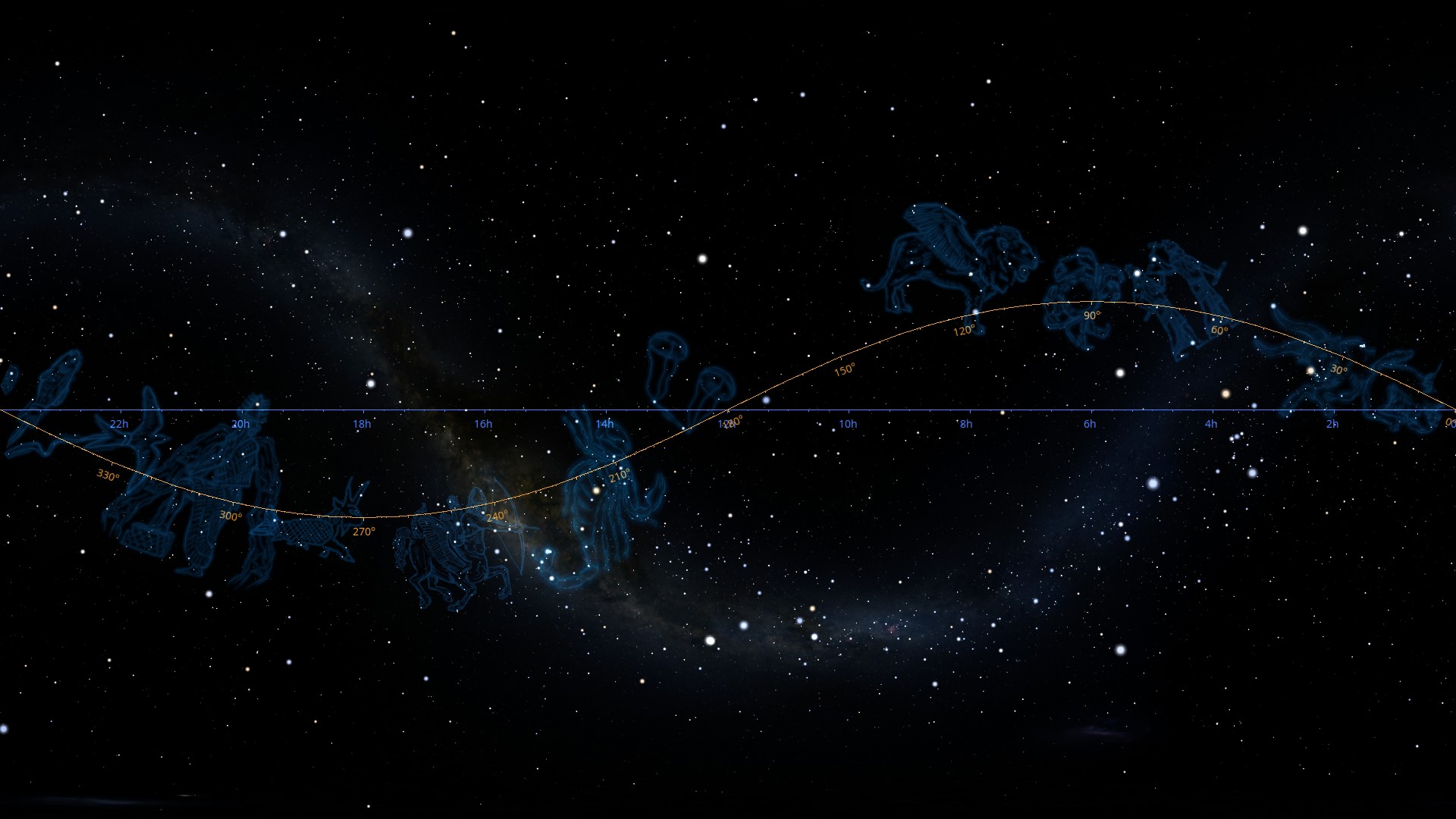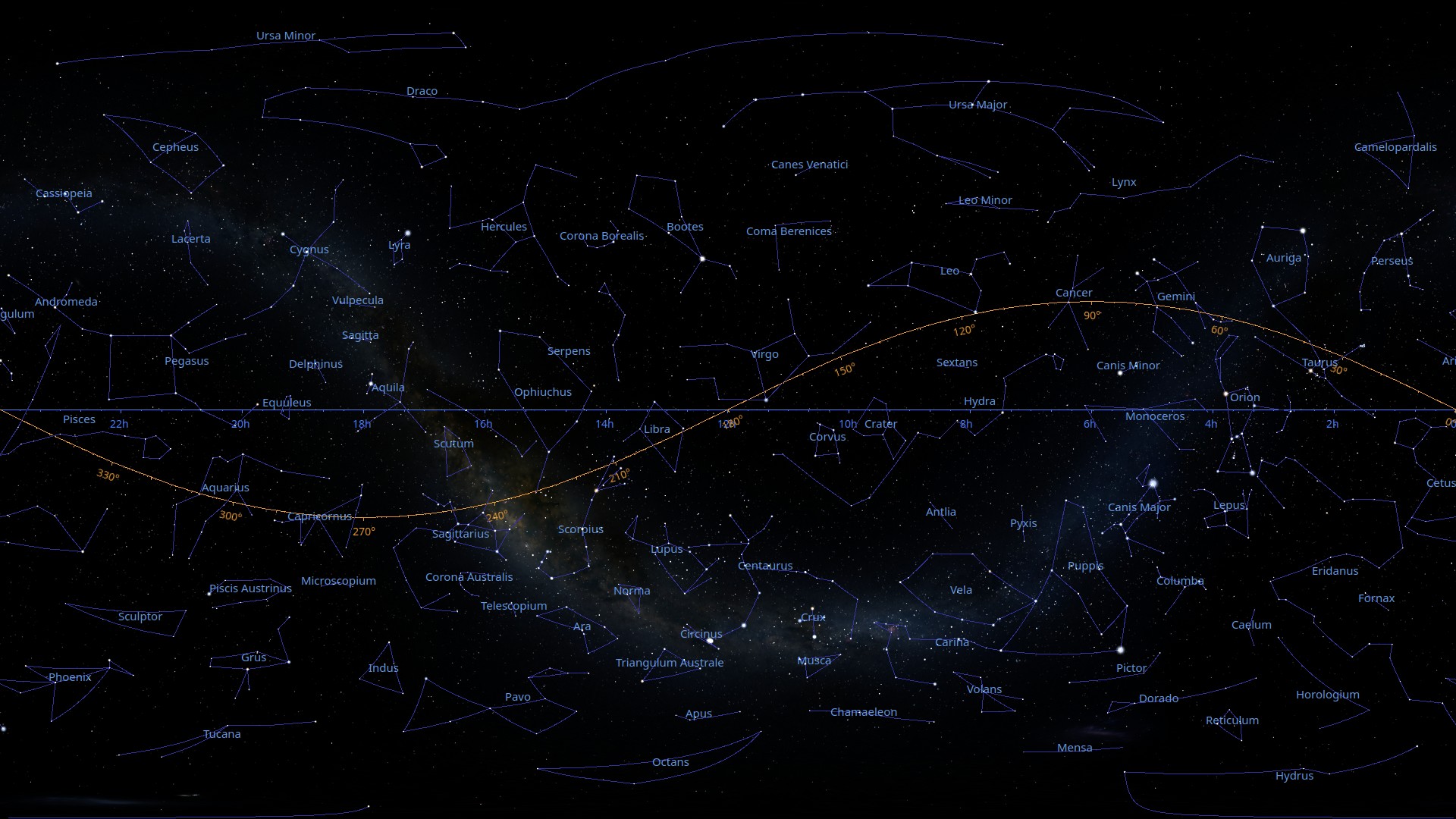Capricorn leaves capricorn
27 May marked a momentous Monday for people who ascribe significance to the interval between 22 December and 19 January everywhere, as it was on this day that Capricorn left Capricorn.[1]
“What?”
For those suitably stocked up on the applicable jargon, it was on this date that the point on the ecliptic with right ascension 20h referenced to B1875, and demarcating the western edge of Capricornus, now has an ecliptic longitude greater than 300°. Armed with this knowledge, you can go do something else now.
“Huh?”
Okay, so we need to step back a bit. Then step back another 2400 years.
The zodiac
Babylonian astronomers noticed that, although you can’t see stars and the Sun at the same time, the stars form a consistent celestial sphere and the Sun traces a fixed path along it. This path is known in the present day as the ‘ecliptic’, and corresponds to the plane of Earth’s orbit as seen from Earth – so every (sidereal) year, as Earth traces a complete orbit, we on Earth see the Sun to get in front of different stars throughout. The Babylonians are pretty clever and can tell what stars are behind the Sun throughout the year, even though they can’t be seen at that moment.
Around 400 BC, they split the ecliptic into 12 intervals of 30°, and associated each with a constellation that appears along it. This system provided a method of describing the positions of objects in the sky.

Equirectangular projection of the celestial sphere of 400 BC. The equator crosses the middle horizontally, and the north pole (think ‘Polaris’) spans the entire top edge. This latter convention means the numbers along the middle are all reversed, but we do this because otherwise people from the northern hemisphere get very upset when you don’t affirm how special they are.
Image generated with Stellarium 1.22.5. Constellation artwork by R. Perdok and Susanna M Hoffman, licensed under CC BY-ND 4.0.
The orange line in the figure above indicates the ecliptic, showing all the stars the Sun passes over the course of a year. Ecliptic longitude, given in degrees, and right ascension, given in hours along the equator, are measured from the point of the March equinox, where the Sun crosses the ecliptic in a northward direction.
Not long afterwards, the Babylonian star catalogs were appropriated by the Greeks due to the efforts of Alexander the Great. The Greeks, and in particular Ptolemy, codified much of western astrology, drawn from this division of the ecliptic. When it made its way to Rome, the modern Latin names for the constellations of the zodiac were born, such as Aries the ram, spanning ecliptic longitudes from 0° to 30°. A planet might be said to be ‘entering Aries’ when its ecliptic longitude enters this interval, and ‘leaving Aries’ once it exits. Then the time of Aries itself is simply when the Sun itself is ‘in’ Aries – from the March equinox (defined as 0°) until it has traversed 30° of the sky, taking approximately one month.

The Babylonian sky as we would describe it today. Note the names of constellations along the yellow ecliptic. If you’ve ever heard of Ophiuchus, this might be why – it touches the same ecliptic, but doesn’t correspond to any of the twelve historical zodiacal divisions.
The rest of the zodiac is defined similarly – Taurus represents ecliptic longitudes from 30° to 60°, Gemini for 60°–90°, and so on up to Capricorn as 270°–300°, Aquarius as 300°–330°, and finally Pisces as 330°–0°.
Okay, so what’s this about Capricorn ‘leaving’ Capricorn?
Precession of the equinoxes
There’s a bit of a problem in the above. Not as written; my explanation is naturally faultless. But even in the centuries around the turn of the millenium, astronomers such as Hipparchus and Ptolemy knew there was a bit of a discrepancy. See, the zodiac is referenced to the tropical cycle, of the seasons and equinoxes. When the March equinox hits, Aries begins. But the names are drawn from constellations, and those distant stars don’t give a coronal mass ejection what Earth is doing or about its equinoxes. And it turns out what Earth is doing is spinning ever so slightly, such that the equinoxes occur a little earlier every year.
The net result of that is, if you were to pin the ecliptic coordinates against the stars, the next March equinox would occur with the Sun slightly shy of 0°, and then the equinox after that would be even further off. Except the zodiac is not pinned to the stars, so the point given by 0° (the ‘first point of Aries’) drifts westwards along the ecliptic. How big is this discrepancy? Well it’s not much… but it’s not small. With a great deal of consistency, it amounts to about 20.4 minutes each year,[2] or a degree of the sky every 70 years.
Fast forward 2400 years, and things add up. So now we’re ready to snap back to reality.
The equator stays in the middle. What’s over that equator changes as the north and south poles (top and bottom edges) roll around a point in Draco (upper left) and Dorado (lower right).
The modern day
Things have changed. The first point of Aries, once marked by the start of the ram, has already slipped all the way back through Pisces and is nearing Aquarius. The various signs still have the same meaning they always had, in terms of ecliptic longitude, but are increasingly divorced from the constellations that name them. They’re only really useful for describing the positions of things close to the ecliptic, though. How might we segment the entire sky to describe the positions of objects in two dimensions?
Around the 18th century, astronomers had named constellations for regions beyond the ecliptic, in no small part simply for the convenience than for any perceived significance of the shapes of any stars themselves.[3] In this regard it’s not too different from the Babylonians’ twelvefold partition of the ecliptic, with patterns of stars having no real significance beyond a descriptive name and memorable appearance for each region. By the early 20th century, a consistent set of about 90 constellations were in use by astronomers to refer to the broad locations of stellar objects, with the International Astronomical Union officially settling on the modern set of 88 at its first general assembly in 1922.
Only one problem remained: no firm deliniation existed between them, leaving ambiguity whether an object between two constellations should be ‘in’ one or the other. Resolving this was the task of Belgian astronomer Eugène Delporte, who defined lines in equatorial coordinates that divide the sky into 88 unambiguous regions, while maintaining the contemporary associations between stars and constellations. Thanks to these efforts, we can speak of Capricornus as encompassing exactly this region:

Capricornus, at the J2000 epoch. Diagram from [IAU_constellations], licensed under CC BY 4.0.
These constellations are described in a coordinate system that tracks the stars themselves rather than Earth’s shifting equinoxes, since a particular date (Besselian epoch 1875) is part of the definition and the boundary can thus be carried backward and forward through time with appropriate models and observations of terrestrial motion.
Brought together… or apart
So we know there’s a region of the sky that represents the modern constellation of Capricornus. We also know that the interval of ecliptic longitudes from 270° to 300° is historically associated with ‘Capricorn’, and although the stars in that region (and all along the ecliptic) would now be observed at greater ecliptic longitudes, the nomenclature endures.
And thus we know what happened at the end of May in 2024: precession of the equinoxes has brought the March equinox more than 300° from the boundary of modern Capricornus, and hence beyond the western zodiac sign of ‘Capricorn’.